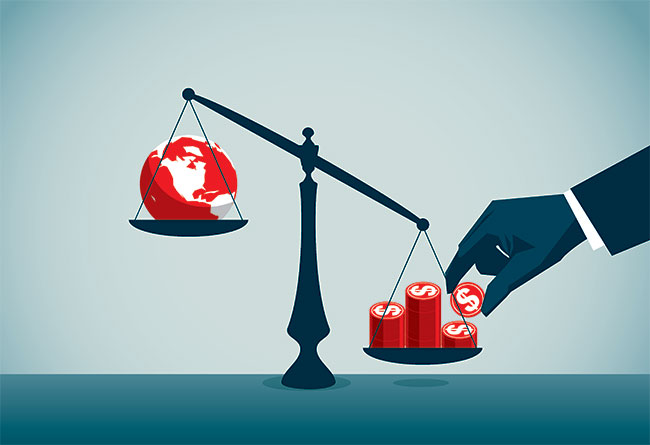••• health care research
Worth a shot
Study examines flu shot sentiment in light of COVID-19
 Due to the COVID-19 pandemic, the 2020 flu season is top-of-mind for Americans more than ever. Research from RxSaver and Kelton Research sheds light on Americans’ perceptions and plans for protection regarding flu vaccinations this year.
Due to the COVID-19 pandemic, the 2020 flu season is top-of-mind for Americans more than ever. Research from RxSaver and Kelton Research sheds light on Americans’ perceptions and plans for protection regarding flu vaccinations this year.
As the COVID-19 pandemic continues into late 2020, it has become a driving force for those planning to receive the flu vaccine, with at least three in five Americans (63%) saying they are more likely to get the flu shot because of the virus. Fifty percent of Americans confirmed they would definitely be getting the flu shot this year, with 44% saying fear of becoming ill due to COVID-19 plays a role in their reasoning, while 68% say they want it for personal protection.
Interestingly, the results also show that where you live plays a role in how likely you are to get the flu shot. Americans from the Northeast (57%) and West (54%) are significantly more likely than those from the South (45%) to say they will definitely receive the flu vaccine this year.
For those who do not plan to get the flu shot, there are considerable reasons why they are choosing not to get the vaccine this year. Twenty-eight percent of this group are afraid of the common side effects associated with the flu shot and 28% also worry they will end up contracting the flu virus after receiving the shot. These concerns are the most common reasons why people have opted to not get vaccinated in the past and still prove to be lingering fears this year. Interestingly enough, 28% of those who do not plan to get the flu vaccine state the reason they won’t be getting the vaccine is due to being more concerned about COVID-19 at this time versus the flu virus.
In addition to health concerns topping the list for many this year, financial hardships due to loss of employment or missing work due to being sick with the flu are also pressing concerns for consumers. Missing work because of illness continues to cause financial challenges for many. Over three in five (61%) employed Americans say they have been impacted financially due to missing work related to a cold or flu, up from 55% in 2019. In fact, 48% admit to searching for discounts on routine purchases to help offset lost wages, while an additional 48% of respondents had to set a strict financial budget as a result of lost income. Many Americans continue to struggle finding the money to pay for needed prescriptions and 30% say they find it challenging to pay for medication that treats a cold or flu. Gen Z/Millennials (49%) are twice as likely as older generations (24%) to say a cold or the flu has adversely impacted them financially.
The research was conducted by Kelton Research on behalf of Rx Saver and surveyed 1,052 nationally representative Americans.
••• entertainment research
Seeing ourselves
Study looks at representation in popular movies
 The Geena Davis Institute on Gender in Media and data and analytics company MOVIO teamed up to determine if what and who is presented on cinema screens affects who shows up for a film during its theatrical run. The research sought to understand how the presence of certain groups (race/ethnicity, gender, age) on-screen draws the corresponding audience and what negative or positive portrayals of certain groups different viewers are seeing in the most popular films. Additionally, the study looked into what portrayals of certain groups child viewers are seeing in the most popular films. On-screen data and audience demographic data for the top 100 films (by box office) in the U.S. were examined for 2018 and 2019.
The Geena Davis Institute on Gender in Media and data and analytics company MOVIO teamed up to determine if what and who is presented on cinema screens affects who shows up for a film during its theatrical run. The research sought to understand how the presence of certain groups (race/ethnicity, gender, age) on-screen draws the corresponding audience and what negative or positive portrayals of certain groups different viewers are seeing in the most popular films. Additionally, the study looked into what portrayals of certain groups child viewers are seeing in the most popular films. On-screen data and audience demographic data for the top 100 films (by box office) in the U.S. were examined for 2018 and 2019.
The research found that people really do want to see themselves reflected on screen. Moviegoers being able to identify with the characters in a movie drives their attendance behavior. When there are characters of a certain cohort this is likely to drive more moviegoers of the same cohort.
The analysis showed across all films that the leading characters and audience are generally 50/50 female/male. This is encouraging considering in 2007 only 23% of leads were female and in 2017 30% were female. However, it is worth noting that the more female characters, the more female the audience and the more male characters, the more male the audience.
The effect of genre on the percentage of male vs. female leading characters was clear as well as the corresponding gender split in the attending audience. Action movies, most notably, regularly have well over 50% male characters and well over 50% (and frequently over 60%) male audience. The opportunity for Black, Asian and Latinx moviegoers to see themselves represented on screen is significantly lower than for white moviegoers. Several movies tally 100% of their characters as white with the majority having over 50% white characters. For the remaining four race/ethnicity groups identified in the study, the majority of films are clustered at below 25% (if not 0%) representation on screen. This is significant considering people of color comprise 37.8% of the U.S. population.
Across the board in terms of ethnicity, gender and age, the negative portrayal of characters from a certain group has little bearing on whether or not that group attends a movie. However, particularly with regards to race and ethnicity, the analysis again shows how minority audiences are given substantially fewer opportunities to even see characters from their racial or ethnic group on the screen, no less characters from their racial or ethnic group who are also not depicted negatively.
The research was also able to determine what demographic cohorts are being represented in films geared primarily towards children. Both male and female leads are roughly evenly split in terms of on-screen representation for films with more child visits, suggesting that young moviegoers are getting a fairly balanced representation of genders in their on-screen media consumption. However, when looking at race/ethnicity there is less of a balanced representation. White characters are very well represented in children’s films, with the majority of films having 50% or more white characters represented on screen. There is not the same level of representation for Asian or Latinx characters in children’s media as the vast majority of films moviegoers are bringing their children to see have no representation of these cohorts. For example, of all the titles analyzed, only six titles had over 18% Latinx characters, despite Latinx people comprising 18.4% of the U.S. population.
The study examined on-screen data and audience demographic data for the top 100 films released theatrically in the U.S. in 2018 and 2019. The study utilized MOVIO’s cinema loyalty data and demographic profiles of over 10 million active U.S. moviegoers.
••• insurance research
To insure or not insure
Study examines life insurance differences in Black and white Americans
 Research from Haven Life reveals that Black Americans are more underinsured than white Americans, despite being more likely to have life insurance. Median incomes for Black and white survey respondents are similar – Black respondents earn $50,162 and white respondents earn $54,823. Eighty-one percent of Black respondents indicate they have life insurance, either through work or individually, compared to 70% of white respondents. Yet when asked about their existing life insurance coverage amounts, white individuals state they have a median coverage amount of $150,000, while Black individuals report having $50,000 in coverage.
Research from Haven Life reveals that Black Americans are more underinsured than white Americans, despite being more likely to have life insurance. Median incomes for Black and white survey respondents are similar – Black respondents earn $50,162 and white respondents earn $54,823. Eighty-one percent of Black respondents indicate they have life insurance, either through work or individually, compared to 70% of white respondents. Yet when asked about their existing life insurance coverage amounts, white individuals state they have a median coverage amount of $150,000, while Black individuals report having $50,000 in coverage.
Black and white respondents similarly think their death would financially impact their loved ones. Sixty-two percent of Black respondents believe their death would have a “substantial” impact on their family’s financial futures compared to 61% for white respondents. However, Black respondents are more likely to view life insurance as a key component to build generational wealth. When asked about the reasons why life insurance is needed, “building generational wealth” is nearly three times more important for Black respondents (22%) than white respondents (8%).
White respondents are more likely to buy life insurance to protect their families from unpaid debts, such as a mortgage. Sixty-four percent of white respondents believe paying off debts is the primary reason for buying life insurance, versus 37% for Black respondents. Of note, the Urban Institute reported that 71.9% of white Americans own homes, compared to 41.8% of Black Americans.
Black respondents were more likely to overestimate the cost of life insurance. Of respondents who do not have life insurance, Black respondents believed the average cost is 30% higher ($65 per month) than white respondents ($50 per month). Even with the perceived higher cost, though, 41% of Black respondents said they “plan to buy life insurance” versus 19% of white respondents. Overall, the survey results show that there are key differences in how Black and white respondents view life insurance. Black individuals appear to value the idea of life insurance more than white individuals and consider coverage to be an important component for building generational wealth. However, Black individuals do not purchase as much coverage and are subsequently more likely to be underinsured.
The study was conducted by Haven Life and polled 653 U.S. adults between 18-65 who identified as either Black only (N=264) or white only (N=389). The median respondent’s age was 34.
••• gaming research
A game for everyone
Study looks at behaviors and preferences of mobile gamers

Every day, millions of people play mobile games on their smartphones. To better understand this audience, AdColony partnered with DISQO to survey 1,200 verified U.S. mobile users about their mobile gaming behaviors, preferences and sentiments.
Since March, mobile gaming has seen as much as a 62% uptick in time-spent, corresponding to the beginning of lockdowns across the U.S. While most people don’t necessarily self-identify as gamers, mobile gaming activity is widespread and evenly distributed among genders, age groups, education levels and income brackets.
Nearly one-half (49%) of Americans play mobile games once or several times a day, while 16% play weekly and 13% play monthly. Even among working-age consumers, females and highly educated consumers, those numbers stay consistent. Fifty-three percent of consumers between 35 and 54 play daily and 49% of those who play daily are women. Among those with higher education, some post-grad (54%) and master’s (51%) have even higher rates of daily mobile gaming than the population at large. Sixty-five percent of consumers with household incomes of $250,000 play mobile games once or several times a day but only 29% of those in the group self-identify as a “gamer.”
Seven out of 10 mobile users “sometimes” or “always” multitask while playing games, and watching TV is the most common other activity (60%), followed by listening to music (46%) and eating or cooking (38%).
Puzzle and word games are most popular of mobile games, with the highest use among all age groups, and both genres skew female over male. Nearly 30% of affluent (HHI $250k+) consumers say they play puzzle and word games the most, as do 44% of those in the $150,000 to $199,000 bracket.
Strategy and role-playing games (RPGs) are most popular among those with higher degrees; one out of five consumers with a master’s or doctorate degree play RPGs, a higher percentage than the general population, with nearly one in three playing strategy games. They also tend to be younger, with most in the 18-44 age group. Strategy games attract male and female players at relatively similar rates (17% of males vs. 15.8% of females).
When asked for their preference, nine out of 10 respondents said they would choose to watch an ad to get rewards like in-game currency rather than paying for the same perk and more females than males would make that choice (92% vs. 86%). Less than 10% of consumers across all age groups would pay for an in-game perk instead of watching an ad to receive the same reward. Those with HHI of $150,000+ had the highest percentage that preferred rewarded videos.
The study was conducted by DISQO on behalf of AdColony and surveyed 1,200 verified mobile users in the U.S.
••• shopper insights
The struggle is real
Online shoppers encounter barriers
 While online shopping was already popular among consumers, the COVID-19 crisis has made this route a preference or even a necessity to many. And yet many retailers don’t offer an optimal experience for shoppers – recent research from goMoxie revealed that 40% of consumers struggle to complete basic tasks on retail websites and that most are more likely to abandon the experience or switch to a competitor rather than seek assistance. The findings are especially concerning given the challenges many retailers already face as a result of the COVID-19 pandemic. These challenges are likely to be exacerbated during the oncoming holiday shopping season.
While online shopping was already popular among consumers, the COVID-19 crisis has made this route a preference or even a necessity to many. And yet many retailers don’t offer an optimal experience for shoppers – recent research from goMoxie revealed that 40% of consumers struggle to complete basic tasks on retail websites and that most are more likely to abandon the experience or switch to a competitor rather than seek assistance. The findings are especially concerning given the challenges many retailers already face as a result of the COVID-19 pandemic. These challenges are likely to be exacerbated during the oncoming holiday shopping season.
eMarketer predicted that in 2020, e-commerce sales will climb by 18% to reach $709.78 billion, representing 14.5% of total U.S. retail sales. While this increased volume suggests expanded opportunities for online retailers, the high levels of struggle and abandonment indicate that many of these businesses are failing to realize their full sales potential.
The most common forms of struggle for consumers come down to easily avoidable failures. Consumers could greatly benefit from retailers guiding them with proactive and relevant information throughout the purchase path. Guide customers when they arrive to the site, through product selection and check out as well as when they return for service and support. Forty-three percent of consumers who struggled while shopping online cited insufficient, incorrect or confusing information via mobile. Again, 43% reported difficulties in site navigation, while 42% were unable to complete a transaction. Thirty-six percent encountered an error message and 22% reported password or login challenges.
E-commerce websites make support channels available. Unfortunately, shoppers are far more likely to give up and leave – making it essential to take a proactive approach to guidance. When encountering a struggle online, 62% abandoned the shopping experience and 52% shopped with a competitor. Only 26% contacted customer service.
Some businesses have turned to text messaging and chatbots/virtual assistants but consumers don’t prefer these means of interaction. When asked which channel they prefer to use when contacting a retailer, respondents chose the telephone (33%), e-mail (26%), live chat with an agent (25%), self-service portal (13%), text/SMS message (12%) and chatbot/virtual assistant (8%).
The survey was conducted by goMoxie using SurveyMonkey and polled 1,063 adult consumers in the U.S.
••• environmental research
Who pays for change?
Study identifies attitudes toward climate change
 A study commissioned by Nexans examined American consumers’ attitudes toward climate change and found that more than two-thirds of respondents (70%) are willing to give or donate a percentage of their personal income to support the fight against climate change.
A study commissioned by Nexans examined American consumers’ attitudes toward climate change and found that more than two-thirds of respondents (70%) are willing to give or donate a percentage of their personal income to support the fight against climate change.
Twenty-eight percent indicated they were willing to provide less than 1% of their income; 33% said they would be willing to contribute 1-5% of their income; 6% said they would give between 6-10% of their income; and 3% indicated they would contribute more than 10% of their income. Just under one-third (31%) of those surveyed indicated they were unwilling to give or donate any percentage of their income to support the fight against climate change.
Participants were given the opportunity to choose from seven multiple responses to the question “How should the fight against climate change be paid for?” The majority (59%) replied it should be paid for by “government incentives for both businesses and consumers.” This was followed by “federal, state and/or local taxes” and “conservation programs” (tied at 47%); “business investments” (42%) and “consumer-driven purchases” (33%). Just 9% selected none of the above and 2% selected other. Forty-four percent of respondents are dissatisfied with the job that federal and state governments are doing to address climate change, 35% are somewhat satisfied and 21% are either very satisfied or completed satisfied with government’s role.
Americans expressed overwhelmingly favorable views of wind and solar renewable energy proposals. Specifically, 85% stated being in favor of wind turbines on land (15% against), 83% in favor of wind turbines off the coast (17% against) and 90% in support of solar panel farms (10% opposed).
Those surveyed were asked about their current and changing priorities towards climate change as influenced by the coronavirus pandemic. Thirty-nine percent indicated that climate change was no more and no less a priority due to the current health emergency; just under a third (31%) indicated that climate change is more of a priority while 30% said it was less of a priority. In similar research conducted by Nexans in the United Kingdom, nearly two-thirds (65.8%) of U.K. respondents said they would be willing to donate part of their salary to fight climate change. Furthermore, nearly a third (29%) of U.K. consumers believe that combating climate change has become more of a priority in light of the coronavirus pandemic.
The U.K. research was conducted online by Savanta and surveyed 2,210 respondents ages 16 and older. The U.S. study was conducted online by Researchscape and surveyed 1,013 respondents ages 18 and older.
